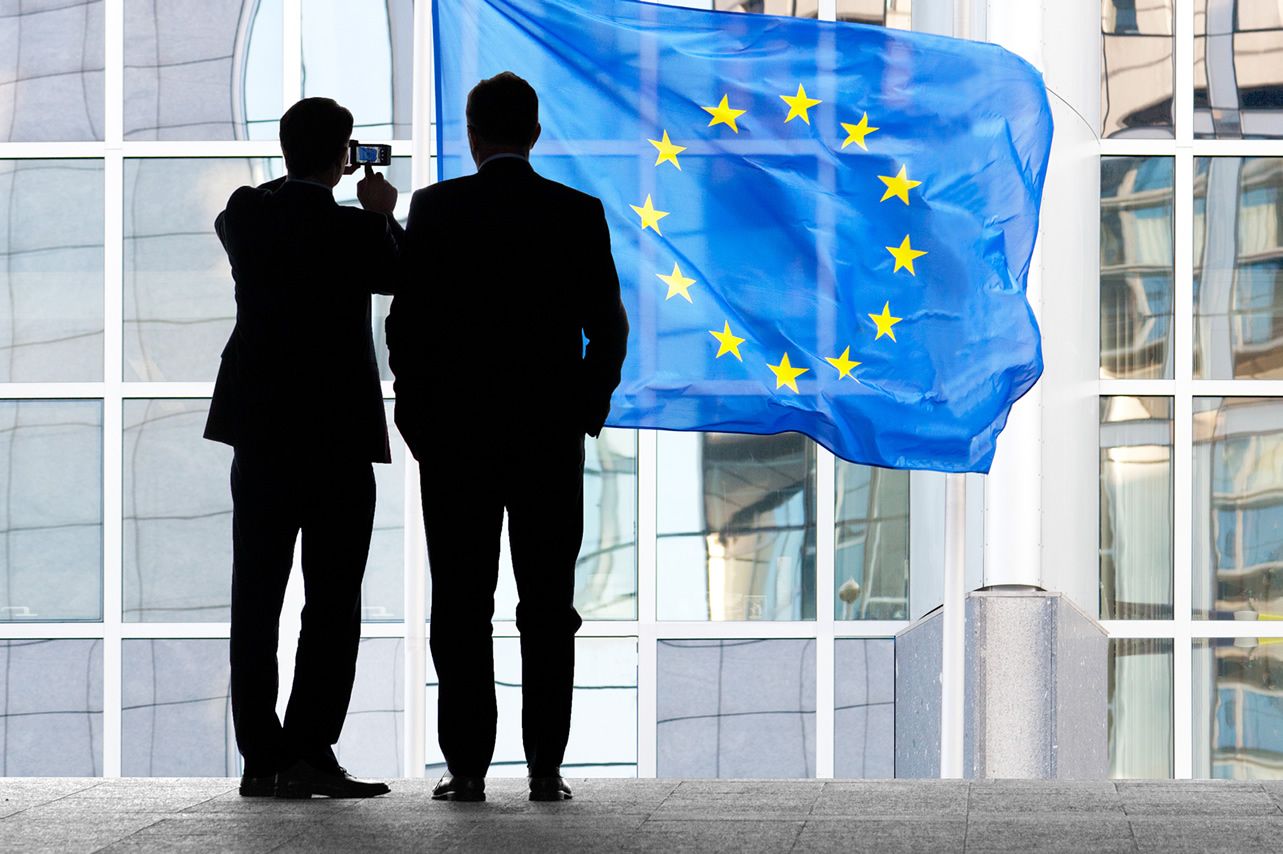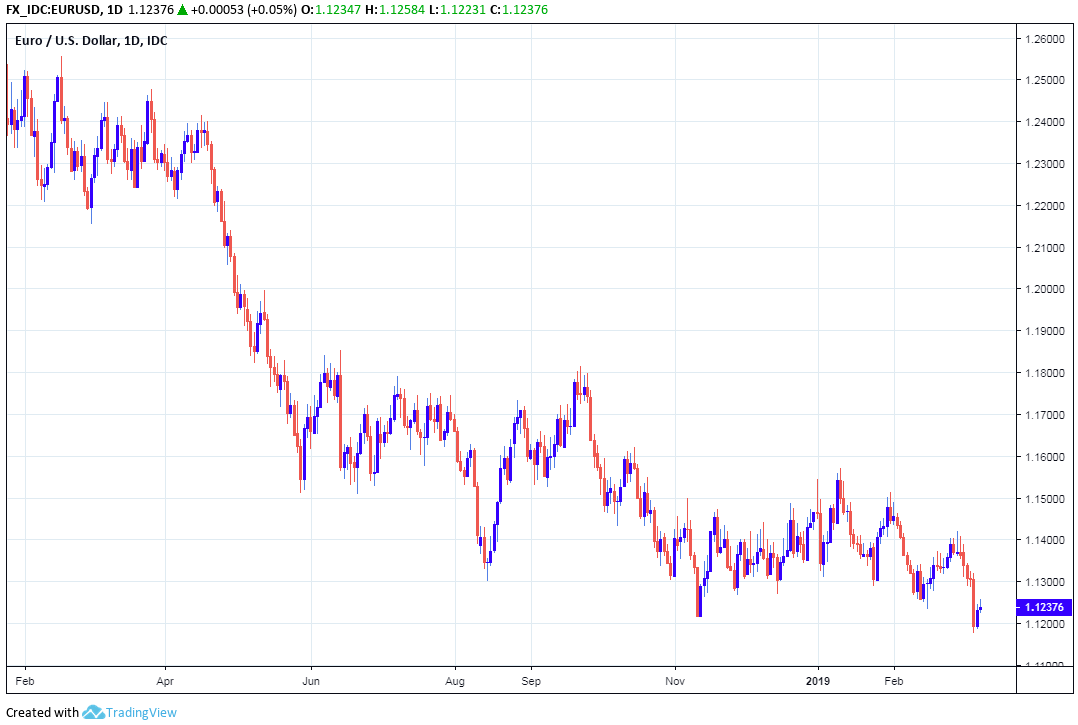The Euro-to-Dollar Rate: Rabobank and Commerzbank Downgrade Forecasts after ECB Interest Rate Shift
- Written by: James Skinner
-

Image © Adobe Images
- Rabobank and Commerzbank cut EUR/USD forecasts after ECB shift.
- Lower-for-longer ECB interest rates will undermine appetite for the Euro.
- Rabobank flags losses ahead, while Commerzbank still predicts gains.
The Euro scored a modest gain over a softer Dollar on Monday but it faces a tough few quarters ahead, according to analysts at Rabobank and Commerzbank, who say the European Central Bank's (ECB) recent change of interest rate guidance has undermined the outlook for the single currency.
Europe's unit is among the worst performers in the G10 basket thus far in 2019 thanks to an ongoing slowdown in the bloc's economy and a resilient Dollar, which remains bid largely due to its status as a safe-haven, investor unease over the outlook for global growth and higher interest rates available in the U.S.
However, even this subpar performance to date will not be enough to insure the currency against further losses during the months ahead. Rabobank says the Eurozone unit will fall back to 2018's lows this year, while Commerzbank has cut all of its forecasts for the Euro-to-Dollar rate in the next two years.
"The dovish signals from the central bank weighed on the EUR," says Jane Foley, a strategist at Rabobank. "Over the medium-term the accommodative position of the ECB should help breath life back in the Eurozone economy. That said, in the absence of an improvement of economic data we expect that the EUR will remain out of favour and expect EUR/USD to drift downwards in the months ahead."
The European Central Bank said last week that its interest rate will not rise from its current crisis-era level until "at least through the end of 2019", when as recently as January it briefed markets that they could potentially expect a rate hike in Autumn this year.
ECB president Mario Draghi also said a new round of cheap loans will be made available for Eurozone commercial banks later in the year. The targeted-long-term-refinancing-operation (TLTRO) is intended to subsidise increased lending across the bloc.
The central bank hopes that lower-for-longer interest rates and other forms of cheap money will encourage a pick-up in economic growth that is sufficient enough to coax inflation back to its target of "close to but below 2%".
"Our old EUR-USD forecast was based on the assumption that the dollar will weaken due to the end of the US hiking cycle and that the euro will appreciate against the dollar when the ECB starts to hike the key rate in 2020. The latter argument is no longer valid," says Antje Praefcke, an analyst Commerzbank.

Above: Euro-to-Dollar rate shown at daily intervals.
Eurozone GDP grew by 1.8% in 2018, down from 2.4% the previous year, while quarterly growth halved from 0.4% to 0.2% during the final six months of the year.
Much of the downturn has its roots in the industrial sector, particularly the manufacturing segment, which is thought to have been hit by a slowdown in the Chinese economy resulting from the trade war with the U.S.
The domestic economy, on the other hand, has remained relatively firm. And official data released this month has revealed that the industrial slowdown was shallower than previously thought.
This leaves alive the possibility of a growth rebound later this year, but doesn't guarantee it, particularly as there is a series of other headwinds waiting just around the corner.
"Darkening political clouds over the Eurozone could be a specific source of pressure on EUR/USD. The result of Spain’s forthcoming general election is likely to draw market attention back to the issue of Catalan separatism," says Foley. "In addition, opinion polls are suggesting that populists are likely to grab a greater share of the vote in May’s European parliamentary elections."
The EU parliament has influence over budget and trade policies, which gives it plenty of scope to cause disruption at the supranational level should a sufficient number of its members become that way inclined.
Foley says uncertainty over future European politics and the European Central Bank's new interest rate guidance mean the Euro will remain on its back foot against the Dollar over the coming months even though the U.S. economy is also expected to slow during 2019.
"We have revised down our 6 month forecast for EUR/USD to 1.10. We have pushed down our 12 mth view to 1.12 from 1.15. In this time frame we see scope for a modest underperformance in the USD in anticipation that fears of a US recession could then be increasing," Foley writes, in a recent note to clients.

Above: Euro-to-Dollar rate shown at weekly intervals.
Praefcke and the Commerzbank team, although having downgraded all of their forecasts, are more optimistic in their outlook for the single currency than Foley and her Rabobank colleagues.
They have long described the Euro as undervalued and are still forecasting a recovery for it in the quarters ahead, which they say will play out as the sun sets on the U.S. economy, although their projections are all lower than they were previously given the new ECB rate guidance.
"The dollar should continue to depreciate against the euro, because the Fed will keep its key interest rate unchanged at 2.50% until the end of 2020," Praefcke writes, in a recent note to clients. "However, since the euro will not be able to benefit from interest rate hike expectations in the foreseeable future, the upward path in EUR-USD starts from lower levels in view of the current weakness of the euro and is ultimately limited. We expect a EUR-USD exchange rate of 1.20 at the end of 2019 and 1.24 at the end of 2020."
Changes in interest rates are normally only made in response to movements in inflation but impact currencies because of the push and pull influence they have over capital flows, and their allure for short-term speculators.
The ECB needs faster growth that is above "potential" in order to get inflation sustainably back to its target level. But the bank cut its 2019 GDP growth forecast from 1.7% to 1.1% last week, and downgraded the likely 2020 expansion from 1.7% to 1.6%.
Inflation was 1.5% in February, up from 1.4% previously, but still a long way off the target. Core inflation, which removes energy items from the goods basket in order to provide a better reflection of domestically-generated price pressures, fell 10 basis points to 1% when consensus looked for a reading of 1.1%.
That latter measure has not been any higher than 1.2% since the ECB began its record-setting stimulus programme that was intended to lift consumer price growth back to its target level by using an artificial compression of bond yields in order to encourage an economic recovery.

Above: Euro-to-Dollar rate shown at monthly intervals.
Time to move your money? Get 3-5% more currency than your bank would offer by using the services of foreign exchange specialists at RationalFX. A specialist broker can deliver you an exchange rate closer to the real market rate, thereby saving you substantial quantities of currency. Find out more here.
* Advertisement




